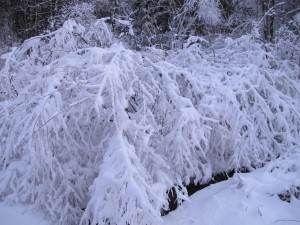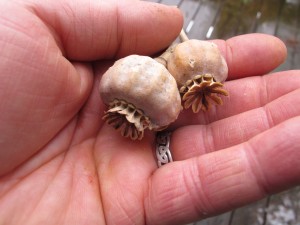Gardening in January
For most of us, gardening in January is limited. Water the houseplants. Read the seed catalogs. Dream of flowering shrubs to add to the perennial border – that sort of thing. But there are activities we can do now– and should.
In late December we had 4 inches of heavy wet snow, followed by cold weather. This resulted in heavy globs of snow and ice frozen to many of our decorative trees and shrubs, and considerable damage. In addition to broken limbs, many branches were bent to the ground – and might stay that way unless we do something.
I went around my garden to knock off snow, or to shake it loose from shrubs that were bent over or burdened by the snow. Some have responded nicely, popping back to their standard shapes, while others may not fully recover until spring.
Of those that bounced back, there is my arctic blue willow (Salix purpurea ‘Nana’). This shrub has varied in its form over the years: for several years it was a classic ‘Nana’ – which means that it was a slow-growing dwarf form. But since I started pruning it a few years ago (or perhaps it hit a teenage growth spurt) it has responded by putting out lots of new growth, sometimes growing as much as 3 feet in a season. I didn’t prune it last fall because the new growth was so distinctive: lots of fine vertical stems in close proximity to each other. It reminds me of a punk rockers hairdo – straight up.
That willow was bent over so that the tips of its branches (which were 6 feet tall or so) touched the ground. I went around gathering armfuls of branches and shaking them gently to shed the snow. The branches did not pop back up and I was worried that the shape of the shrub would be permanently changed. But a couple of days later it is back to its original shape.
I keep my Christmas tree up and in the house until it becomes almost dangerously dry, ready to explode at the first sign of a spark. I consider it a “winter tree” in the New Year and revel in its lights and all the memories the ornaments conjure up. (I have a felt and tinsel Santa from my Mom’s tree that probably came from Germany with her parents around 1900). But if you take down yours before the Ground Hog Day, you can use the branches in the garden.
Evergreen boughs are great to use to protect tender perennials and shrubs. Although we have had good snow cover so far this year, if we get a January thaw followed by very cold nights, frost and cold may penetrate the soil deeply and may kill the roots of tender plants. To prevent that, provide some insulation, particularly for new perennials and shrubs. Place branches over the plants, and then some mulch hay or straw over that. It’s like tucking in your baby at night.
A brief explanation is in order about why some tender shrubs and vines fail to bloom some years. Woody plants make their buds either the summer before and bloom early in the spring or summer on “old wood”. Or they make their buds in spring for summer or fall blooms on “new wood” that grows after winter is over. In the first category are forsythia, lilacs, blueberries and most wisteria. In the second are hydrangeas, summer clethra and Seven Sons Flower tree.
Shrubs that bloom on old wood can lose their blossoms when a cold, strong wind burns off the flower buds. The ‘Endless Summer’ blue hydrangea is sold as a plant that will bloom in June and repeat blooms all summer. But that only happens if the flower buds survive the winter, and often they do not – delaying bloom until late summer on new wood.
Another gardening activity I do when temperatures are below zero is to plant a few poppy seeds outdoors in the snow. I save the seed heads of annual poppies each year in a plastic bag. Then just when winter seems the most oppressive, I sprinkle seeds on the snow over a flower bed that has been cultivated and loose soil on its surface.
Even a cold winter sun will heat up a black poppy seed enough to allow it to melt its way through the snow. If I sprinkle a hundred seeds, at least a few will eventually lodge in suitable places and grow next summer. It’s no work, great fun, and it makes spring seem like a word that is within the realm of the possible -even if the thermometer is below zero.
Henry Homeyer is the author of 4 gardening books and a children’s novel, Wobar and the Quest for the Magic Calumet. Reach him at henry.homeyer@comcast.net or PO Box 364, Cornish Flat, NH 03746.




